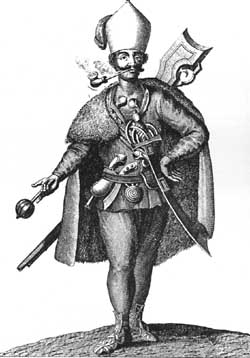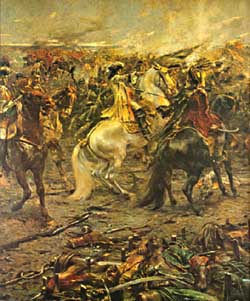|
|
||||||
|
|
||||||
|
|
||||||
|
|
||||||
|
|
||||||
|
|
|
At the end of the VI cent. AD, the Slavs came to this region. During a war (791-796 AD) Charlemagne destroyed the Avar tribe alliance and the Frank state expanded its borders to Fruska Gora. The important changes in social and economic relations took place at the end of the IX cent., when the Hungarians came from the East persecuted by Pecsenegs. They inhabited most of the teritory of the nowadays Vojvodina, where they found the remains of Avars, Slavs and Franks.
The Turks reorganized their troops the drove the Austrians out of the Balkans. In the great migration of the 1690, caused by the Turkish retaliation on Serbian population "looking neiter for the write nor for the wrong, but all under the saber they sent", thousands of Serbs came to Vojvodina led by the patriarch Arsenije III Carnojevic. At the time the Serbs formed the majoritu of the population. Along with them in Backa and Srem lived Bunjevacs and Sokacs, and in Banat the Romanians. The Austrian court guaranteed the Serbs freedom of confession, release of the feudal obligations and autonomy in matters concerning religion and people because the court needed them as protectors of the frontier. Against Turks, a defense system was built, conceived as a Military Frontier. There was the Moris frontier in northern Banat. In Backa, there was the Tisa frontier, along the Tisa river, and the Sava and the Danube frontier along these two rivers. As emperors frontier keepers Serbs and Bunjevacs, who were obliged to serve both as soldiers and border keepers, were released from feudal taxes, and they had a village self government, with national officers as governors. The Military Frontier was thought of as of an "Austrian house's treasury", because the court could use the Frontier men as soldiers in wars against outer enemies, as well as an instrument of power in inside conflicts. The engagement of frontier men is illustrated by the fact that they participated in 13 wars from 1690 to 1802, that is they spent 90 years out of 112 fighting wars.<�ÙBR>  Since Vojvodina had been raided and robbed during the Turk reign and the fields were uncultivated, after the defeat if the Turks, Austrians began to settle German population from Germany and northern Hungary. At the beginning of the 18th century Backa and Banat were underpopulated. The settlers were needed to turn the swamps and steppes into cultivated fields and for the renewal of trades and commerce. Since Vojvodina had been raided and robbed during the Turk reign and the fields were uncultivated, after the defeat if the Turks, Austrians began to settle German population from Germany and northern Hungary. At the beginning of the 18th century Backa and Banat were underpopulated. The settlers were needed to turn the swamps and steppes into cultivated fields and for the renewal of trades and commerce.Most of the settlers were Germans, who knew how to cultivate fields and they were artisans. The authorities released them from paying taxes in order to motivate them. The Slovaks moved into Vojvodina from the Carpathian Mountains round 1740. They first populated Backa, and later Banat and Srem as well. At the time, Hungarians also came in Backa in great mber. Many of them moved to Banat later. The Chamber had settled the Rusinians to its estates in Backa from 1740 to 1765. They moved to Srem later. The planned settlement of Romanians took place in the second half of 18th century, but many of them had come individually before that even against the will of the authorities. The settlement of Serbs and Croats from Lika, Dalmatia, Serbia and Bosnia was continued. Thanks to the economic progress, that is, to the politics of the Austrian mercantilism, the middle class was strengthened. This class will mark not only commercial, but also the cultural, development of Vojvodina. While the Germans led in European trades, which overpowered the old Balkan trades, Serbs led in commerce, trading with cattle and wheat, and accumulating wealth. The cities were developed as the centers of trades and commerce, but also as centers of culture. The Free Royal Cities had the benefit of administrative and political autonomy. The First Serbian Rise of 1804 had a great impact on Serbs in Vojvodina because of its ideas of social and national liberation. The rise of Tican, named after one of the leaders, Teodor Avramovic Tican, which broke in Srem in April 1807, was not aimed only to improve the position of peasants, but also brought the idea of the national liberation. The people, dissatisfied with the Austrian rule and their own position at the Military Frontier, hoping to get some help from Serbia, started a rebellion at the village of Kruscica near Bela Crkva. Badly prepared and conducted the rise was doomed to fail. The discontent of the peasants and people in general grew to burst out into a revolution in 1848-49. |

 Batle near Senta 1697.
Batle near Senta 1697.